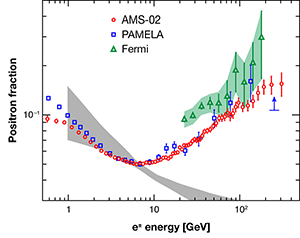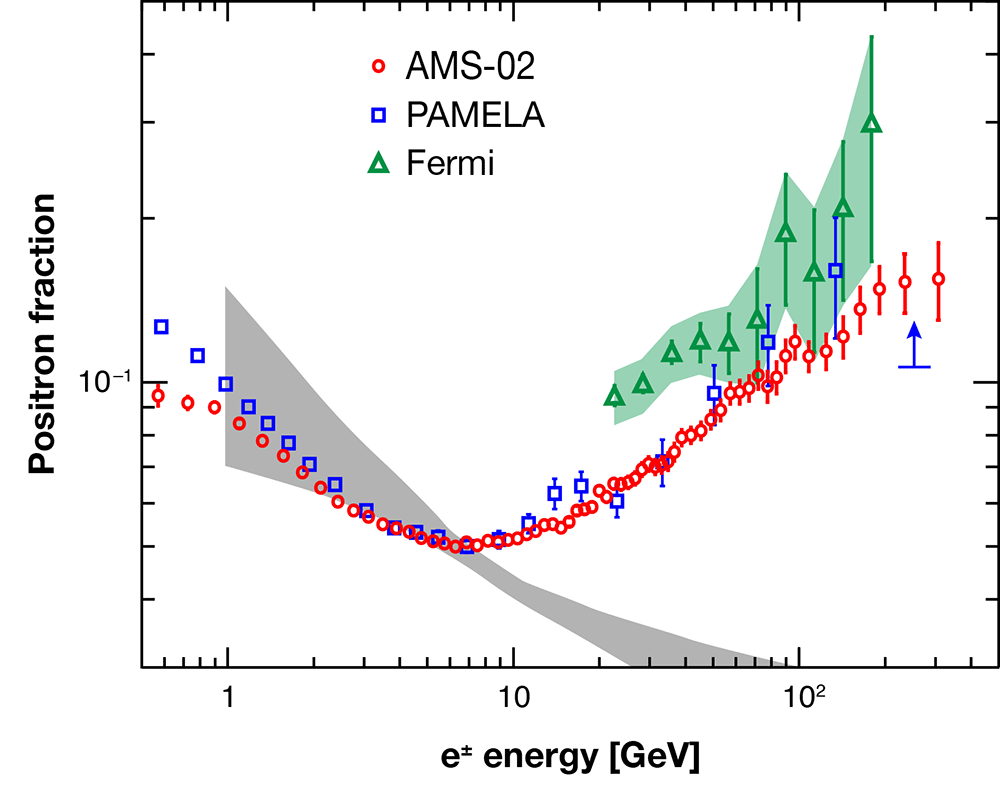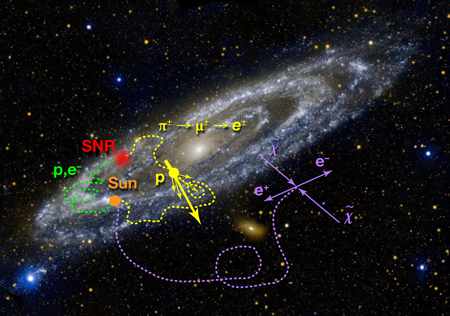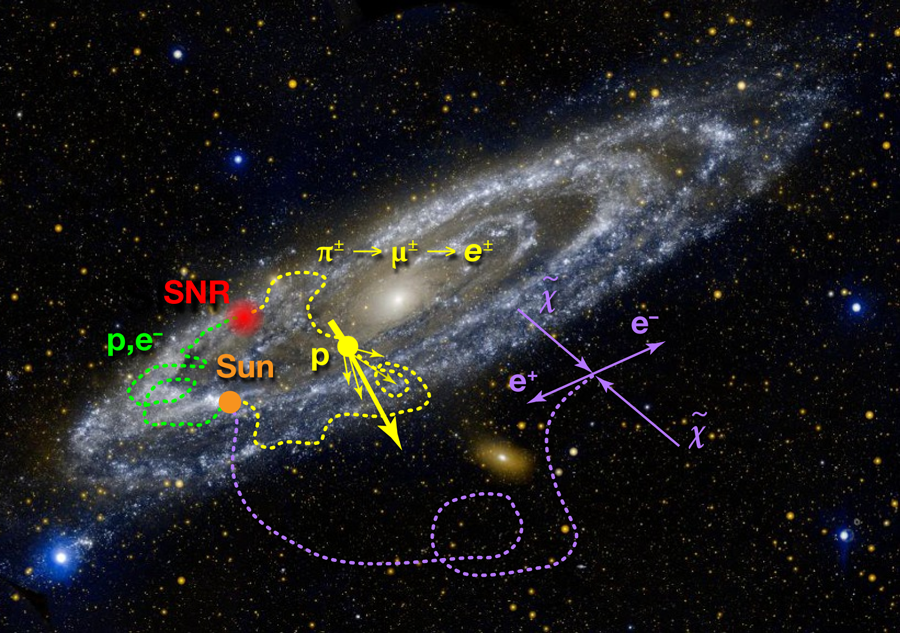Positrons Galore
Antimatter is rare in the universe today. As far as we know, all relic antimatter produced in the big bang disappeared long ago in annihilation reactions with matter particles. What this means is that any antimatter particles that we can detect in the flux of energetic cosmic rays near Earth must have been created by “new” sources within our Milky Way Galaxy. (Antimatter particles from extragalactic sources are also conceivable, but they are exceedingly unlikely to make it to Earth before losing all their energy or annihilating.) Because there is a limited amount of energetic antimatter from space raining down upon the Earth, antiparticles serve as unique messengers of high-energy phenomena in the cosmos, or signatures of exotic new physics.
Now, an eagerly anticipated survey of cosmic-ray positrons—the antiparticle of the electron—is being reported in Physical Review Letters by the collaboration running the Alpha Magnetic Spectrometer (AMS), a particle detector experiment on board the Earth-orbiting International Space Station [1]. In the first scientific report from the AMS, an experiment 18 years in the making that began taking data in May 2011, the collaboration presents a measurement of the “positron fraction,” the ratio of the number of positrons to the total number of electrons plus positrons, at energies between 0.5 and 350 giga-electron-volts ( GeV) (Fig. 1). The 400,000 positrons they have measured constitute the largest set of cosmic-ray positron data, increasing the total world sample a hundredfold. In addition, the range of the reported positron fraction extends out to a few hundred GeV, beyond the reach of previous experiments flown on high-altitude balloons [2] or space shuttles and satellites [3] (see 5 January 2012 Synopsis). The features in the AMS’s positron distribution are a striking confirmation—with unprecedented statistical detail—of what has been reported previously by satellite experiments: an excess of positrons over what we expect from known galactic energetic phenomena. There is a tantalizing—and much touted—possibility that this excess could be a signature of dark matter, though it’s much too soon to rule out more prosaic explanations.
Antimatter arises as a by-product of ordinary cosmic-ray nuclei interacting with the dilute interstellar gas. For example, when an energetic cosmic-ray proton—say, one produced by a supernova remnant—collides with the nucleus of a hydrogen atom in the interstellar medium, the interaction can produce pions. These particles decay into muons and, ultimately, into electrons and positrons in equal numbers. Energetic electrons and positrons arriving at Earth will therefore consist of a mixture of “primary” negatively charged electrons, from the same astrophysical sources that produce cosmic-ray nuclei in the first place, and additional “secondary” positrons and electrons from cosmic-ray interactions (Fig. 2). Based on models of particle interactions and transport processes in the Galaxy [4], particle astrophysicists predict a positron fraction (at Earth) that decreases, monotonically, at energies greater than 1GeV (see the grey band in Fig. 1).
Some 20 years ago, this picture was largely substantiated by spectrometers flown on high-altitude balloons (e.g., the HEAT, TS93, and CAPRICE experiments [2]). But there were also hints of a departure from this behavior at energies beyond about 10GeV, where a larger-than-expected positron fraction seemed to signal the possibility of an additional, unknown source of antimatter. Later, space-borne instruments—such as the AMS-01 (an AMS prototype), PAMELA, and Fermi-LAT—were able to measure this rise in the positron fraction with substantially better statistics and over a wider energy range [3].
There has been no shortage of speculation about what might cause the positron “excess” above 10GeV. One idea is that relatively nearby cosmic bodies, such as pulsars, act as accelerators and colliders that produce antimatter [5], much like our terrestrial Large Hadron Collider. But a more exciting possibility is that the positrons come from the annihilation of dark matter particles, which may populate the Milky Way and its halo [6]. Dark matter is, after all, a dominant form of the matter-energy budget of the Universe, but we don’t know its particle nature or how it interacts with itself and with normal matter (other than through gravitational interactions). It is no overstatement to say that identifying the dark matter is one of the greatest problems in modern science.
This is why the particle astrophysics community has been eagerly awaiting a confirmation of the positron fraction features seen by PAMELA and Fermi-LAT. The AMS is the most complex particle physics experiment in space. It includes a battery of detectors that can identify the mass, charge, and energy of particles and antiparticles with high precision, in particular, by tracking the particles’ deflection through a permanent magnet located at the core of the instrument. The latter is a capability that Fermi-LAT doesn’t have, which is one reason why there were such large uncertainties in its positron spectrum. And all of these detector experiments are faced with the challenge of precisely identifying positrons at high energies, where the background is copious. A 100-GeV positron resembles a 100-GeV proton in many respects, but protons outnumber positrons by some three orders of magnitude—a problem that becomes worse with energy.
The new AMS results agree beautifully with what PAMELA observed, thus reinforcing the trend that the positron fraction rises with energy, but this time, with unprecedented statistics and background controls. Although there is an apparent discrepancy between the PAMELA and new AMS data below about 2GeV, it is not a concern: cosmic particles have to swim upstream against the solar wind to reach Earth and the effects of this “solar modulation” on the particle populations may be different for the two instruments. Such effects should become negligible beyond a few GeV.
With so many experiments pointing to an excess of antimatter, we’re now in a position to ask the following: Where does it come from? This may take a while to resolve. There are many theoretical scenarios, all with enough uncertainties that they seem endlessly adaptable to every quirk, kink, or hint of structure in the positron spectrum. One can invoke energetic gamma rays that convert into electron-positron pairs in the vicinity of the magnetic poles of pulsars [7]. One can imagine that positrons are produced in the decay of radioisotopes within a cosmic accelerator, say a supernova remnant [8]. And, there is the exciting possibility that all of these experiments have seen the “smoking gun” signal of dark matter particles annihilating in the galactic halo [6]. There are significant modeling uncertainties in all of these scenarios, though, such as how particles propagate through the Galaxy, the mass of the dark matter particles, and their interaction rates. But the ideas are attractive and remain fodder for lively speculation.
How will we tell? The AMS collaboration doesn’t speculate in their first report. No doubt many ideas will be generated along with attempts to fit the AMS positron fraction to favored models, while accommodating constraints that come from other experiments [9–11]. But perhaps a definitive answer will eventually be forthcoming. For one thing, the new AMS data have an unprecedented sensitivity to the curvature and features in the positron spectrum. Already, we can see a significant change of slope in the positron fraction near 100GeV that will need to be explained. The AMS is only two years into its projected ten-year (or longer) lifetime. There are predictions that the error bars on the data will decrease further. There should also be measurements of the positron fraction spectrum up to higher energies, and a separate measurement of the absolute energy spectra of positrons and electrons. But we will have to be patient: the particle fluxes fall off rapidly with energy, so accumulating precise data above 200GeV or so will be a painfully slow affair. Meanwhile there will be a wealth of other data to come from the AMS. The experiment is in an excellent position to identify antiprotons, cosmic-ray nuclei, and more speculatively, to search for antinuclei.
References
- M. Aguilar et al. (AMS Collaboration), “First Result from the Alpha Magnetic Spectrometer on the International Space Station: Precision Measurement of the Positron Fraction in Primary Cosmic Rays of 0.5–350 GeV,” Phys. Rev. Lett. 110, 141102 (2013)
- HEAT: J. J. Beatty et al., “New Measurement of the Cosmic-Ray Positron Fraction from 5 to 15 GeV,” Phys. Rev. Lett. 93, 241102 (2004); TS93: R. Golden et al., “Measurement of the Positron to Electron Ratio in the Cosmic Rays above 5 GeV,” Astrophys. J. 457, L103 (1996); CAPRICE: M. Boezio et al., “Measurements of Cosmic-Ray Electrons and Positrons by the Wizard/CAPRICE Collaboration,” Adv. Sp. Res. 27, 669 (2001)
- AMS-01: M. Aguilar et al., “Cosmic-Ray Positron Fraction Measurement from 1 to 30 GeV with AMS-01,” Phys. Lett. B 646, 145 (2007); PAMELA: O. Adriani et al., “An Anomalous Positron Abundance in Cosmic Rays with Energies 1.5-100 GeV,” Nature 458, 607 (2009); Fermi-LAT: M. Ackermann et al., “Measurement of Separate Cosmic-Ray Electron and Positron Spectra with the Fermi Large Area Telescope,” Phys. Rev. Lett. 108, 011103 (2012)
- R. J. Protheroe, “On the Nature of the Cosmic Ray Positron Spectrum,” Astrophys. J. 254, 391 (1982); I. Moskalenko and A. Strong, “Production and Propagation of Cosmic-Ray Positrons and Electrons,” 493, 693 (1998); T. Delahaye, J. Lavalle, R. Lineros, F. Donato, and N. Fornengo, “Galactic Electrons and Positrons at the Earth: New Estimate of the Primary and Secondary Fluxes,” Astron. Astrophys. 524, A51 (2010)
- H. Yuksel, M. D. Kistler, and T. Stanev, “TeV Gamma Rays from Geminga and the Origin of the GeV Positron Excess,” Phys. Rev. Lett. 103, 051101 (2009)
- L. Bergstrom, J. Edsjo, and G. Zaharijas, “Dark Matter Interpretation of Recent Electron and Positron Data,” Phys. Rev. Lett. 103, 031103 (2009)
- S. Profumo, “Dissecting Cosmic-Ray Electron-Positron Data with Occam’s Razor: The Role of Known Pulsars,” Cent. Eur. J. Phys. 10, 1 (2012)
- V. N. Zirakashvili and V. S. Ptuskin, “Numerical Simulations of Diffusive Shock Acceleration in SNRS,” Astropart. Phys. 39-40, 12 (2012)
- M. Ackermann et al., “Constraints on the Galactic Halo Dark Matter from Fermi-LAT Diffuse Measurements,” Astrophys. J. 761, 91 (2012)
- O. Adriani et al., “PAMELA Results on the Cosmic-Ray Antiproton Flux from 60 MeV to 180 GeV in Kinetic Energy,” Phys. Rev. Lett. 105, 121101 (2010)
- M. Ackermann et al., “Fermi LAT Observations of Cosmic-Ray Electrons from 7 GeV to 1 TeV,” Phys. Rev. D 82, 092004 (2010); O. Adriani et al., “Cosmic-Ray Electron Flux Measured by the PAMELA Experiment between 1 and 625 GeV,” Phys. Rev. Lett. 106, 201101 (2011)







